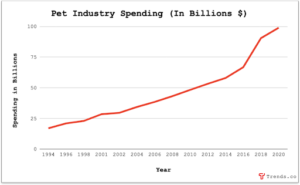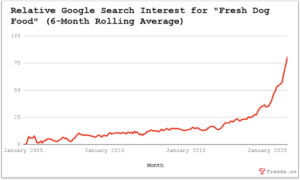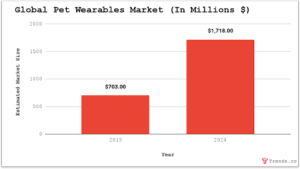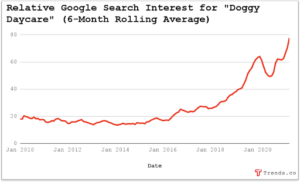What’s Trending: Man’s best friend will always be man’s best friend and the ongoing pandemic accelerated the willingness to spend on his furry friend. The growth keeps climbing with no signs of slowing.

Over the last quarter century, the industry has not seen a single year of negative growth. Pet lovers don’t see their spending as optional — making for a recession-proof market. “Animal humanization” has caused funding to soar:
- $65m VC raised in the first 3 months of 2021 ($61m of this in the US)
- Surveyed owners saying “pets are family”: 90% in 2019 to 95% in 2020
- Pet insurance: US market leader Trupanion’s revenue grew 31% YoY to reach $502m in 2020, and UK-based Bought by Many raised $350m this June
- Shelter pet adoptions, boosted by the pandemic, continued to surge this year (notably, with a ~25% lower return rate. We’re not crying, you are)
The Opportunity: There are plenty of new opportunities to capitalize on this ever-growing industry. Here are three to chew on:
High-End Food
Nowhere is the humanization of pets more pronounced than in the food segment. The era of dry kibble is over; enter human-testedpet meals (and you thought lavender macaronswere just for your afternoon tea).

The fresh pet food market is expected to reach $1.1B+ by 2026. Demand is particularly high in the US and Australia. Current US market leader The Farmer’s Dog has 1.5m+ site visits/month.
And there is still time for more to enter the space and compete with fresh, personalized food options. Raw dog food is a high-growth niche. Mirroring human food trends will be another profitable approach.
Entrepreneurs could also focus on treats and special occasions. Per Google Trends, searches for “cake for dogs near me” hit an all-time high this June — a 450%+ increase from just a year ago (no, our dog did not write this).
Pet Wearables
The market for pet wearables is forecast to reach $1.7Bwithin the next 3 years, at a 19.6% CAGR.

Source: MarketsandMarkets
Owners’ desire to monitor their precious pooches while away is driving demand for connected smart collars and harnesses that track everything from location to emotional state.
Entrepreneurs could focus on personalized gear, user-friendly apps, data analysis, or connected ranges (wearables that link to smart food and water bowls, pet doors, treat dispensers, etc.). Manufacture/sourcing of required tech components such as sensors is another option.
Niching down to develop wearables for the growing number of exotic pets is also an attractive route, as are rental options for pet tech (that will come with a high price tag).
Doggy Day Care
Google search interest for doggy day care centers hit an all-time high in 2H 2021.

Someone please let the dogs back in. Source: Google Trends
Enrolling Fido in day care can cost $240-$550/month (excluding overnight boarding and weekend stays).
Demand will soar as owners trickle back into the office post-pandemic.
People looking for at-home pet services are also rising: Dog boarding and walking app Rover had 100k downloads last month, hot off a February announcement about plans to go public.
Next Steps:
If you haven’t already thought about this exploding sub-category in pet healthcare, it is certainly something to pounce on now.
Prospect smAARt, pitch with purpose, and most importantly, with passion.

As 2021 comes to a close, we’re seeing a few trends among the industry:
1. The hurry up and wait game continues between agencies and their marketer partners.
2. Relationships have become more transactional.
3. End of year demand is coming in hot!
Catch up on this quarter’s smAARt Huddle here!
Customers today may live and breathe online- but 74% of them are more concerned about the privacy of their data now than ever before.
It’s critical for your agency to produce work that meets privacy compliance for your customers.
In our latest Lesson Session, Audrey Glover Dichter is covering everything your agency needs to know about Privacy Law.
Inside, you’ll learn:
-3 Legal Must-Haves For Your Website
-6 Cybersecurity Law Back End Requirements
-The Ultimate Overview of Global Privacy Laws Advertisers Need to Know
-The 8-Tip Privacy Law Checklist
Check it out here!
For more information about Audrey Glover Ditcher and her practice, connect with her on LinkedIn here.
No one likes to say no to a new business opportunity. Yet, every opportunity needs to be evaluated properly to decide whether to pitch or ditch the prospective client. Competitive pitches are expensive, time consuming, disruptive and sometimes downright chaotic so you must evaluate what you are getting into before saying, “yes.”
But how should you go about evaluating the opportunity and what are some of those checkboxes that should be checked before moving forward?
Here are some to keep in the back of your mind the next time you’re invited into a pitch process. Of course, some of these vary depending on the type of review, the bench strength you have and the talent available.
Let’s break the questions down into four main buckets:
- What are the benefits for the agency should your agency win this account?
- What are the benefits for the client should your agency win the account?
- What do we know about the client team?
- What is the process that you will need to undergo to pitch the account?
Let’s start with the benefits for the agency. There are many questions that fall into this section but three that really stand out are:
- Is there good short-term revenue potential?
- Is this a long-term client that is 4+ years?
- Does the brand have strong future potential where the agency will grow with the brand and have a solid margin?
- What is the reputation of the brand? Have you done a quick social media audit to understand audience engagement and sentiment?
Next is the benefits for the client (which are also benefits for your agency) should the agency win the account. Again, there are many evaluation points but the top ones fall into:
- Can the agency do emotive and innovative work for this brand (and can you use this work to drive PR value for your agency)?
- Has the agency solved similar marketing challenges for other brands in the recent past within and outside of the category?
- Can the agency truly provide all the necessary disciplines needed to address the key marcom challenges at hand for the brand?
Third is evaluating the client team and this is just as vital as evaluating the brand itself.
- Is the CMO or lead decision maker involved in the entire review process?
- What is the background of the key decision makers? Education? Career path? Are they on a particular board? Can you get a sense of them personally, as well as professionally? What’s their reputation?
- Is there any connection to any client team members within your agency?
Lastly, what is the process that you will need to endure and is it worth the potential win?
- Is the process laid out in advance with a clear agenda, timeline and reasonable deadlines?
- Who is running this process and are they competent to manage the review properly?
- Is the assignment a fair ask compared to the “size of the prize”?
- Is your IP protected and not compromised as a result of the pitch process?
And finally, why is the brand going into review? Is it a mandatory review? If so, what are the chances for the incumbent to retain the business? If it’s not a mandatory review, what are the reasons for the review – are they rational, emotional, fully endorsed and supported from the top down?
It’s easy to get excited about a new opportunity but careful consideration and evaluation is vital before diving into any pitch. It’s the old 80/20 rule. It’s best to try to keep competitive pitches to 20% of your new business strategy since they come with a price to pitch.
There you have it. That’s my counsel on this topic and I hope it helps. Look out for more of my new biz quick tips shared exclusively with AAR Agency Growth Program Partners…
Whether or not you have a “million-dollar swing,” golf is on fire… Both on and off the course.
The last time golf experienced a spike in participation, the young Tiger had just won his 1st major championship.
Once again, the golf business is booming.
The Golf Boom: Why It’s Important?
On the course, more people are playing the game than pre-pandemic:
- 24.8m+ people played at least 1 round of golf in the US in 2020, a 2%+ increase YoY (the biggest jump in 17 years)
- Beginner participation increased by the largest margin since 1997
But it’s more than just the pandemic forcing people outside — through July 2021, the number of rounds played was up 16.1% from 2020, proving the trend has staying power.
Off the course, there are more ways to enjoy the game than ever before, including:
- TopGolf, which offers a gamified driving range experience with food and drinks, has seen a 30% growth rate since 2017
- Indoor golf is on the rise thanks to simulator technology, allowing people to play indoors year-round
The Opportunity?
Between TopGolf, indoor golf, and traditional driving ranges, another 12.1m people enjoyed the game last year without having to book a tee time.
Golf manufacturers and retailers are reaping the benefits
In the first half of fiscal 2021, Acushnet, which operates brands like Titleist and FootJoy, saw sales pop by 75% in the US. Dick’s Sporting Goods also called out golf as a major growth area in a recent earnings call.
With the PGA working on a Netflix documentary series modeled after Formula 1’s “Drive to Survive,” this could all become (dare I say it)…“Par for the course.”
Prospect smAARt, pitch with purpose, and most importantly, with passion.
Here’s wishing you a hole-in-one!




